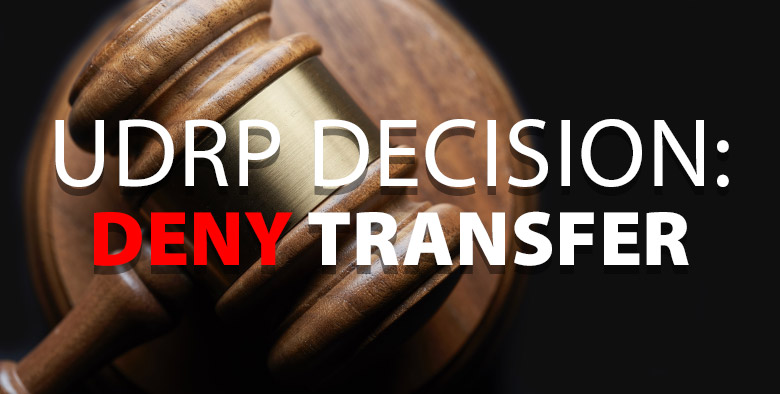Timik.com was taken to the WIPO and the UDRP process, after the Complainant rejected the $85,000 dollar asking price.
The Complainant is Timik Group AB of Sweden, that offered $4,000 dollars to acquire Timik.com on the Uniregistry market platform.
Citing trademarks registered in 2017, the Complainant failed to win this case, as the domain was registered in 2008.
The panelist ordered Timik.com to remain with the Respondent, despite no response from the Korean Respondent.

The domain transfer was denied.
Full details follow:
Copyright © 2025 DomainGang.com · All Rights Reserved.Timik Group AB and Timik AS v. Admin
Case No. D2020-03741. The Parties
The Complainants are Timik Group AB, Sweden and Timik AS, Norway (collectively the “Complainant”), represented by Advokatfirmaet GjessingReimers AS, Norway.
The Respondent is Admin, Republic of Korea, self-represented.
2. The Domain Name and Registrar
The disputed domain name <timik.com> is registered with Gabia, Inc. (the “Registrar”).
3. Procedural History
The Complaint was filed with the WIPO Arbitration and Mediation Center (the “Center”) on February 17, 2020. On February 17, 2020, the Center transmitted by email to the Registrar a request for registrar verification in connection with the disputed domain name. On February 26, 2020, the Registrar transmitted by email to the Center its verification response confirming that the Respondent is listed as the registrant and providing the contact details.
On March 3, 2020, the Center notified the Parties in both English and Korean that the language of the registration agreement for the disputed domain name is Korean. On March 4, 2020, the Complainant requested for English to be the language of the proceeding. The Respondent requested for Korean to be the language of the proceeding.
The Center verified that the Complaint satisfied the formal requirements of the Uniform Domain Name Dispute Resolution Policy (the “Policy” or “UDRP”), the Rules for Uniform Domain Name Dispute Resolution Policy (the “Rules”), and the WIPO Supplemental Rules for Uniform Domain Name Dispute Resolution Policy (the “Supplemental Rules”).
In accordance with the Rules, paragraphs 2 and 4, the Center formally notified the Respondent in English and Korean of the Complaint, and the proceedings commenced on March 12, 2020. In accordance with the Rules, paragraph 5, the due date for Response was April 1, 2020. The Respondent did not submit any formal response. Accordingly, the Center notified the Parties on April 2, 2020, that it would proceed to panel appointment.
The Center appointed Andrew J. Park as the sole panelist in this matter on April 14, 2020. The Panel finds that it was properly constituted. The Panel has submitted the Statement of Acceptance and Declaration of Impartiality and Independence, as required by the Center to ensure compliance with the Rules, paragraph 7.
4. Factual Background
The Complainant Timik Group is a Nordic healthcare company that focuses on medical devices and equipment for the treatment and diagnosis of chronic diseases and is a Nordic distributor for many international manufacturers in the United States of America, Germany, Switzerland, the United Kingdom, China, and other countries.
The Complainant has been using the name “Timik” since the beginning of 2017. They contacted the Respondent through Uniregistry Corp., an intermediary, and offered USD 4,000 for the assignment of the disputed domain name. Uniregistry Corp., on behalf of the Respondent, countered-offered with an assignment price of USD 85,000. The Complainant rejected said counter-offer.
The Complainant is the owner of the following TIMIK trademark registrations:
Country
Trademark
International Classes
Registration Number
Sweden
TIMIK
10,11 and 28
1396027
Norway
TIMIK
10, 35, 37, 41, 42 and 44
294148
Denmark
TIMIK
10, 11, 28, 35, 37, 41, 42 and 44
1396027
Finland
TIMIK
44
1396027
The disputed domain name <timik.com> was registered by the Respondent on August 6, 2008.
The disputed domain name resolves to a website that has been inactive since it was created, and the Respondent has shown no actual intention to use the disputed domain name.
As noted above, the Complainant, following the filing of the Complaint with the Center, requested for English to be the language of the proceeding. The Respondent requested Korean to be the language of the proceeding.
5. Parties’ Contentions
A. The Complainant
The Complainant contends that the disputed domain name should be transferred to the Complainant because:
1) the disputed domain name <timik.com> is identical and confusingly similar to the Complainant’s TIMIK trademark in which the Complainant has rights in terms of appearance, pronunciation, and meaning.
2) the Respondent has no rights or legitimate interests in the disputed domain name. The Complainant contends that the Respondent has no rights or legitimate interests in respect of the disputed domain name because the Respondent shows no active use of the disputed domain name nor preparations for such use since its registration in 2008. The Respondent has not demonstrated any use of the disputed domain name for a bona fide offering of goods or services, other than offering the domain name for sale. Also, the Respondent is not commonly known by the disputed domain name and it has neither obtained any trademark rights identical and related to the disputed domain name. In fact, the Respondent has offered several times to transfer the disputed domain name to the Complainant for consideration of USD 85,000, which is excessive for a domain name, and therefore, it cannot be said that the Respondent is making a legitimate non-commercial or fair use of the disputed domain name, without intent for commercial gain, misleadingly diverting consumers, or to tarnish the trademark at issue.
3) the disputed domain name was registered and is being used in bad faith. The Complainant claims that the Respondent has acquired and registered the disputed domain name in bad faith primarily for the purpose of selling, renting, or otherwise transferring the domain name registration to the owner of the trademark for valuable consideration in excess of the Respondent’s out-of-pocket costs directly related to the disputed domain name. The Respondent has offered to transfer the disputed domain name to Complainant for the total amount of USD 85,000, which is excessive and a disproportionate amount for a domain name.
B. The Respondent
The Respondent requested for Korean to be the language of the proceeding. However, the Respondent did not reply to the Complainants’ contentions.
6. Discussion and Findings
A. Language of Proceeding
The registration agreement for the disputed domain name is in Korean. Pursuant to paragraph 11 of the Rules, unless otherwise agreed by the parties, or specified otherwise in the registration agreement, the language of the proceeding shall be the language of the registration agreement, i.e., Korean.
Having considered the circumstances of the case, the Panel decides that English be adopted as the language of the proceeding under paragraphs 10 and 11(a) of the Rules. In coming to this decision, the Panel has taken the following into account:
1) The Complaint has been submitted in English and it would cause undue delay and expense if the Complainant was required to translate the Complaint and other documents into Korean;
2) The Panel is proficient in both English and Korean, capable of reviewing all the documents and materials in both languages and giving full consideration to the Parties’ respective arguments; and
3) The Complainant and the Respondent use different languages, and neither of them likely understand the language of the other party. Therefore, English would be a fair language for both Parties.
In light of these circumstances, the Panel concludes that it will (1) accept the Complaint in English; (2) consider any relevant materials in Korean; and (3) issue a decision in English.
B. Identical or Confusingly Similar
This element consists of two parts: first, whether the Complainant has rights in a relevant trademark and, second, whether the disputed domain name is identical or confusingly similar to that trademark.
The Panel finds that the Complainant has established registered rights in the mark TIMIK and that the disputed domain name is identical to the Complainant’s trademark. The disputed domain name incorporates the Complainant’s trademark in its entirety, and the addition of the gTLD extension “.com” may be disregarded when assessing whether a domain name is identical or confusingly similar to a trademark (see Proactiva Medio Ambiente, S.A. v. Proactiva, WIPO Case No. D2012-0182).
For these reasons, pursuant to the Policy, paragraph 4(a)(i), the Panel finds that the disputed domain name is identical or confusingly similar to the Complainant’s trademark.
C. Rights or Legitimate InterestsPursuant to paragraph 4(a)(ii) of the Policy, the Complainant is required to make out a prima facie case that the Respondent lacks rights or legitimate interests in the disputed domain name. Once such a prima facie case is made, the Respondent carries the burden of demonstrating its rights or legitimate interests in the disputed domain name. If the Respondent fails to do so, the Complainant is deemed to have satisfied paragraph 4(a)(ii) of the Policy. See WIPO Overview of WIPO Panel Views on Selected UDRP Questions, Third Edition (“WIPO Overview 3.0”), section 2.1.
Here, the Panel finds that the Complainant has made out a prima facie case.
The Panel finds no evidence of record to show that the Respondent has an actual intention to use the disputed domain name since it registered the disputed domain name in 2008. Indeed, the website to which the disputed domain name resolved to has been inactive. There is nothing in the record to suggest that the Respondent has made a legitimate noncommercial or fair use of the disputed domain name or has been commonly known by the disputed domain name. Also, there is no evidence that the Respondent has an intention to use the disputed domain name in connection with a bona fide offering of goods or services.
Further, the Panel notes that while the overall burden of proof is on the Complainant, panels in past UDRP decisions have recognized that proving a respondent lacks rights or legitimate interests in a domain name may result in a potentially impossible task of “proving a negative”, requiring information that is often primarily within the knowledge or control of the respondent. In this case, since the Complainant has been found to have made a prima facie case that the Respondent lacks rights or legitimate interests, the burden of production shifts to the Respondent to prove its rights or legitimate interests in the disputed domain name. The Respondent, however, failed to come forward with such relevant evidence, and thus, the Panel’s view is that the foregoing facts may be taken as true. Accordingly, the Panel holds that the Complainant has established that the Respondent has no rights or legitimate interests in the disputed domain name pursuant to paragraph 4(a)(ii) of the Policy.
D. Registered and Used in Bad Faith
Paragraph 4(b) of the Policy provides a non-exclusive list of circumstances that evidence registration and use of a domain name in bad faith. Any one of the following is sufficient to support a finding of bad faith:
(i) circumstances indicating that the respondent has registered or acquired the domain name primarily for the purpose of selling, renting, or otherwise transferring the domain name registration to the complainant who is the owner of the trademark or service mark or to a competitor of that complainant, for valuable consideration in excess of the respondent’s documented out-of-pocket costs directly related to the domain name; or
(ii) the respondent has registered the domain name in order to prevent the owner of the trademark or service mark from reflecting the mark in a corresponding domain name, provided that the respondent has engaged in a pattern of such conduct; or
(iii) the respondent has registered the domain name primarily for the purpose of disrupting the business of a competitor; or
(iv) by using the domain name, the respondent has intentionally attempted to attract, for commercial gain, Internet users to its website or other online location, by creating a likelihood of confusion with the complainant’s mark as to the source, sponsorship, affiliation, or endorsement of the respondent’s website or location or of a product or service on the respondent’s website or location.
The Complainant claims that the Respondent registered and is using the disputed domain name in bad faith in violation of the Policy, paragraph 4(a)(iii). Specifically, the Complainant claims that the Respondent violated the Policy, paragraph 4(b)(i) by registering the disputed domain name in order to sell the disputed domain name to the public or to the Complainant in an amount in excess of the Respondent’s costs related to the disputed domain name.
As stated previously, the Respondent did not file any written response to the Complaint, failing thereby to rebut the Complainant’s allegations of the Respondent’s bad faith registration and use of the disputed domain name.
Nevertheless, the Panel still has the responsibility of determining which of the Complainant’s assertions are established as facts, and whether the conclusions asserted by the Complainant can be drawn from the established facts (see Harvey Norman Retailing Pty Ltd v. Oxford-University, WIPO Case No. D2000-0944).
The Panel finds that the Complainant had registered the trademark TIMIK in 2017 and have been using it as their trademark for approximately 3 years. The Panel also finds that the disputed domain name was registered by the Respondent well before the Complainants’ trademark registration date, the website at which the disputed domain name resolved to has been inactive ever since its initial registration and there is no evidence that the Respondent is currently using or is commonly known by, has used or has been commonly known under, or has a bona fide intent to use or be commonly known under the disputed domain name.
The Panel also confirms that the Respondent tried to sell the disputed domain name to the Complainant several times for commercial gain at a price of USD 85,000, which is far in excess of the Respondent’s costs for the disputed domain name.
Taking the entire record into consideration, including the above-noted findings, the Panel concludes as follows:
With respect to the offer to sell, UDRP panels have generally found that the practice of registering a domain name for subsequent resale, including for a profit or for consideration in excess of the Respondent’s costs related to the disputed domain name, would not, by itself, support a claim of bad faith registration with the primary purpose of selling it to a trademark owner or its competitor.
Further, there is no evidence to indicate that the Respondent registered the disputed domain name for the purpose of profiting from or otherwise exploiting the Complainant’s trademark. For example, there is no finding of:
(i) the Respondent’s likely knowledge of the Complainant’s rights. Indeed, the Respondent registered the disputed domain name nearly 10 years before the Complainant secured trademark registration of the subject trademark.
(ii) the website at the disputed domain name is not targeting the Complainant’s trademark (e.g., through links to the Complainant’s competitors)
In addition, in assessing whether the Respondent’s registration of the disputed domain name is in bad faith, the Panel may consider the following: (i) the nature of the domain name (e.g., a typo of a widely-known mark, or a domain name incorporating the complainant’s mark plus an additional term such as a descriptive or geographic term, or one that corresponds to the complainant’s area of activity or natural zone of expansion); (ii) the chosen top-level domain (e.g., particularly where corresponding to the complainant’s area of business activity or natural zone of expansion); (iii) the content of any website to which the domain name directs, including any changes in such content and the timing thereof; (iv) the timing and circumstances of the registration (particularly following a product launch, or the complainant’s failure to renew its domain name registration); (v) any respondent pattern of targeting marks along a range of factors, such as a common area of commerce, intended consumers, or geographic location; (vi) a clear absence of rights or legitimate interests coupled with no credible explanation for the respondent’s choice of the domain name; or (viii) other indicia generally suggesting that the respondent had somehow targeted the complainant.
There is no evidence in the record that any of the above factors exists in this case.
The disputed domain name was registered before the Complainant acquired trademark rights. It is well-established that where a respondent registers a domain name before the complainant’s trademark rights accrue, panels will not normally find bad faith on the part of the respondent. The record in this case clearly shows that the Respondent registered the disputed domain name in 2008, while the Complainant first began using the mark “Timik” in 2017, nearly ten years after the Respondent’s registration date of the disputed domain name.
In conclusion, the Panel finds that there is insufficient evidence to rule that the Respondent registered the disputed domain name in bad faith.
7. Decision
For the foregoing reasons, the complaint is denied.
Andrew J. Park
Sole Panelist
Date: May 12, 2020














Great decision, a slap in the face of the aggressor company.